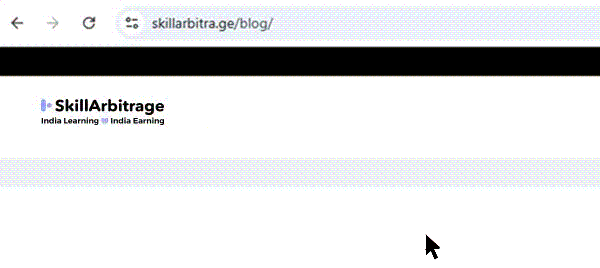Discover how to harness the power of ChatGPT and Claude to generate compelling, well-structured blog posts faster than ever. This blog is your step-by-step guide for content writers, marketing professionals, and small business owners who want to create high-impact blogs effortlessly with the help of AI.
Table of Contents
Introduction
“Another one bites the dust!” My friend said, half smiling and half sad. She was referring to the loss of another client, who paid her a decent fee to write some blog posts every month and had decided to shift to AI recently.
She was not the only one; such things were becoming an everyday occurrence. Every day, more and more clients trusted their content writing business to AI, which was allegedly more efficient, made fewer errors, and was definitely more cost-effective.
But it was also now easier for content writers to create better quality and effective content with AI, but only and only if they know how to use it optimally.
Let’s be honest, since the advent of AI, the content creation game has completely changed. If you’re still grinding through blog posts the old-fashioned way, researching for hours, staring at blank pages, and wrestling with writer’s block, you’re making things way harder than they need to be.
AI has become the secret weapon that separates efficient content creators from those still stuck in the struggle.
But here’s where most writers get it wrong: they think AI is just about speed. They’ll fire off a quick prompt to ChatGPT, copy-paste the result, maybe polish it a bit, and call it done.
That’s not strategic, that’s lazy. And your readers can tell the difference.
The real magic happens when you treat AI tools like what they actually are: incredibly powerful writing assistants that each have their own superpowers. ChatGPT is your rapid-fire brainstorming buddy who can crank out structures and ideas faster than you can think them. Claude is your thoughtful editor who can dive deep into complex topics and help you craft narratives that actually connect with humans.
When you learn to use them together strategically, you’re not just writing faster, you’re writing smarter.
You’re creating content that engages readers, ranks well in search, and actually moves the needle for your business or clients.
This isn’t about replacing your skills as a writer; it’s about amplifying them in ways that would have seemed impossible just a few years ago.
Ready to transform your content creation process?
Let’s dive into a workflow that will save you hours while producing the kind of engaging, high-performing content that gets results.
Why combine ChatGPT and Claude?
Think of ChatGPT and Claude like two different types of colleagues you’d want on your content team.
ChatGPT is that energetic brainstormer who can rapid-fire ideas, create outlines in seconds, and adapt to any tone you throw at them.
Need 20 headline variations?
- Done.
Want an SEO-optimized structure?
- No problem.
Looking for content that matches a specific brand voice?
- ChatGPT’s got you covered.
Claude, on the other hand, is your thoughtful strategist.
This is the AI that actually thinks through problems, synthesizes complex information, and helps you craft narratives that flow naturally. While ChatGPT excels at speed and structure, Claude brings depth and nuance to the table.
It’s the difference between getting quick answers and getting insightful analysis.
Take a look at this for a better understanding:
Here’s the beautiful thing: Claude and ChatGPT are not competing with each other. These are complementary tools. When you use them together, you essentially get a writer, editor, and content strategist all rolled into one superhuman workflow.
ChatGPT handles the heavy lifting of ideation and first drafts, while Claude refines, analyzes, and elevates your content to something that truly resonates with readers.
ChatGPT is your rapid executor who can turn ideas into action instantly. Claude is your reflective planner who helps you think through strategy and ensure everything connects. Together, they create a dynamic that most solo writers could never achieve on their own.
1. Find winning topics & keywords
The biggest mistake most content creators make is jumping straight into writing without doing the strategic work upfront.
You need topics that your audience cares about and keywords that can drive traffic. This is where the ChatGPT-Claude combo becomes your secret weapon.
Start with ChatGPT for rapid topic generation. This tool excels at brainstorming because it can pull from its vast training data to suggest ideas you might never have considered.
Here’s a prompt that works incredibly well:
“Suggest 10 trending topics for [your specific industry] that include low-competition keywords. Focus on problems my audience faces daily and include potential long-tail keyword opportunities.”
Replace “[your specific industry]” with something like “B2B SaaS marketing,” “sustainable fashion,” or “small business accounting.”
ChatGPT will generate a list of topics that are both relevant and searchable. The key is being specific about your niche; the more targeted your prompt, the better your results.
But don’t stop there. Take those ideas to Claude for the real strategic evaluation. Claude’s strength lies in its ability to analyze and prioritize based on deeper reasoning.
Use this prompt:
“Here are 10 blog topic ideas for [your ideal customer profile]. Rank them by potential audience engagement and suggest emotional hooks that would make each topic irresistible to click and read.”
Claude will not only rank your topics but also give you insights into why certain topics might perform better than others.
The two tools, when taken together, are deadly effective. ChatGPT gives you the raw material and keyword potential, while Claude helps you understand which topics will actually connect with your audience on an emotional level.
After running both analyses, shortlist 1-2 ideas that hit the sweet spot: decent keyword potential plus strong audience alignment.
Use this two-step process to ensure you’re creating content that both search engines and humans will love.
2. Craft a strategic outline
Once you’ve nailed down your topic, it’s time to create an outline that actually works. Most writers either skip this step entirely (mistake #1) or create outlines that are too vague to be useful (mistake #2).
A strategic outline is your roadmap, it should be detailed enough that writing becomes almost automatic.
ChatGPT is perfect for creating comprehensive first-draft outlines. It can structure your thoughts, suggest subheadings, and even include tactical elements like CTAs.
Try this prompt:
“Create a detailed blog outline for [your topic] targeting [your audience]. Include H2 and H3 headings, key bullet points for each section, and suggest where to place a compelling call-to-action. Write in a [conversational/professional/educational] tone.”
ChatGPT will give you a solid foundation with proper heading hierarchy, logical flow, and all the structural elements you need. But structure isn’t everything—you need to ensure your outline actually resonates with your audience and tells a compelling story.
This is where Claude comes in. Take your ChatGPT-generated outline to Claude for strategic refinement:
Use this prompt:
“Review this blog outline for [your target audience]. Suggest improvements for logical flow, identify any content gaps, and recommend ways to increase audience engagement. Focus on storytelling elements and pain-point mapping.”
Claude will analyze your outline from a strategic perspective. It might suggest reordering sections for better flow, identifying missing elements that your audience would expect, or recommending ways to weave in storytelling elements that make your content more engaging.
The result? An outline that’s not just well-structured but strategically sound. You’ll have a clear direction for each section, smooth transitions between ideas, and a logical progression that keeps readers engaged from start to finish.
3. Research & generate insights
Research is where many writers either go overboard (spending hours down rabbit holes) or cut corners (relying on surface-level information).
The key is strategic research that gives you credible insights without eating up your entire day.
Claude is particularly strong at research synthesis. It can take complex information and distill it into insights that are both accurate and accessible.
Start with this prompt:
“Summarize the most recent insights on [your topic] from the past 12 months. Include different perspectives, highlight any opposing viewpoints, and identify emerging trends that most people might not be aware of yet.”
Claude will give you a comprehensive overview that goes beyond basic information. It’s particularly good at identifying nuances and contradictions in the research, which can actually make your content more interesting and credible.
But complex insights need to be made accessible to your audience. This is where Claude’s ability to create analogies and frameworks becomes invaluable:
Use this prompt:
“Explain [complex concept from your research] using a metaphor or analogy that a general audience would understand. Create a simple framework that breaks down the key components.”
Once you have your insights, use ChatGPT to help you organize them into digestible formats:
Use this prompt:
“Take these research insights and condense them into 5 actionable tips that [your audience] can implement immediately.”
Here’s a crucial point: always verify AI-generated data with external sources. While both ChatGPT and Claude are remarkably accurate, they’re not infallible. Cross-reference important statistics, check dates on studies, and make sure your sources are credible. Your reputation depends on the accuracy of your information.
The goal of this research phase isn’t to become an expert overnight, it’s to gather enough credible, interesting insights to support your main points and provide real value to your readers.
4. Write the first draft
This is where the rubber meets the road. You’ve got your topic, your strategic outline, and your research. Now it’s time to turn all that preparation into actual content.
ChatGPT excels at turning outlines into full drafts. It can maintain consistency, follow your structure, and adapt to whatever tone you specify.
Use this prompt:
“Write a complete blog post based on this outline. Write in a [conversational/professional/educational] tone for [your target audience]. Make sure each section flows naturally into the next and include specific examples where appropriate.”
Don’t expect perfection on the first try. Instead, request multiple options for key sections, especially your introduction.
Your intro is crucial; it determines whether readers stick around or bounce.
Try this prompt:
“Write 3 different introduction options for this blog post. Make each one focus on a different hook: one with a surprising statistic, one with a relatable story, and one with a provocative question.”
Once you have your draft, this is where Claude becomes invaluable for enhancement. Claude can take good content and make it great by adding depth, clarity, and impact.
Use this prompt:
“Review this section of my blog post. Enhance it with specific examples, strengthen the arguments, and improve clarity without changing the overall tone or message.”
Here’s a workflow tip that works incredibly well: aim to write about 30% of your content yourself and let AI handle the other 70%, then revise everything to maintain your unique voice.
The parts you write yourself should be the most personal, the most strategic, or the most brand-specific elements. Let AI handle the explanatory sections, examples, and structural elements.
The key is maintaining your voice throughout the process. AI should amplify your ideas and insights, not replace them.
Your unique perspective, experiences, and opinions are what make your content valuable, AI just helps you express them more effectively.
5. Optimize for SEO naturally
SEO optimization is where many writers either go overboard (keyword stuffing) or completely neglect (missing optimization opportunities). The goal is to make your content search-friendly without sacrificing readability or natural flow.
ChatGPT is excellent at integrating keywords seamlessly. Instead of forcing keywords into awkward places, it can weave them naturally throughout your content.
Use this prompt:
“Take this blog post and naturally incorporate these target keywords: [list your keywords]. Avoid keyword stuffing and maintain the conversational tone. Focus on semantic variations and related terms.”
Don’t forget the technical SEO elements. ChatGPT can help you create compelling titles, meta descriptions, and URL slugs that both search engines and humans will love.
Try this prompt:
“Create 5 different SEO-optimized title options for this blog post, each under 60 characters. Also create a meta description under 160 characters that includes the main keyword and compelling reason to click.”
But SEO isn’t just about keywords, it’s about matching search intent. This is where Claude’s analytical abilities shine:
“Analyze this blog post for alignment with [your main keyword] search intent. What are people really looking for when they search this term? Suggest adjustments to better match their expectations.”
Claude can help you identify opportunities for featured snippets, which can dramatically increase your visibility:
“Rewrite this key section to answer the question in a format that’s optimized for featured snippets. Keep it under 40 words and make it a complete, standalone answer.”
Remember, the best SEO strategy is creating genuinely useful content that answers real questions. Use tools like Surfer SEO or Clearscope for final validation, but don’t let SEO requirements override good writing.
Search engines are getting better at recognizing quality content, so focus on serving your readers first.
6. Align tone & brand voice
Tone consistency is what separates professional content from amateur content. Your readers should be able to recognize your voice across every piece of content you create, but maintaining that consistency while using AI can be tricky.
ChatGPT is particularly good at mimicking specific tones when given clear direction:
“Rewrite this section to match the tone of this sample content: [paste a paragraph from your best-performing content]. Focus on sentence structure, word choice, and personality while keeping the core message intact.”
But tone isn’t just about individual sections. It’s about overall consistency throughout your piece. Claude excels at spotting tone shifts and inconsistencies that might slip past you:
“Review this entire blog post for tone consistency. Highlight any sections where the voice feels robotic, overly formal, or inconsistent with the overall conversational tone. Suggest specific fixes.”
Here’s a pro tip: Use Claude to create a reusable tone guide from your existing content:
“Analyze these three blog samples and extract the key elements of my brand voice. Create a style guide that includes tone descriptors, preferred sentence structures, vocabulary choices, and personality traits that I can use for future content creation.”
This tone guide becomes incredibly valuable for creating prompt templates. Instead of describing your desired tone from scratch every time, you can reference your established style guide.
This ensures consistency across all your AI-assisted content while saving time on prompt creation.
Building a library of effective prompts is one of the smartest investments you can make in your content creation process. Document what works, refine what doesn’t, and create templates that maintain your brand voice while leveraging AI’s capabilities.
7. Final draft review
The review process is where good content becomes great content. It goes far beyond just spotting typos. This is the step where you review the content, keeping the goal in mind.
ChatGPT excels at the technical aspects of editing:
“Proofread this blog post for grammar, punctuation, and clarity. Tighten the prose to eliminate wordiness, but don’t change the conversational tone. Also check for any awkward transitions or unclear explanations.”
But technical correctness isn’t enough. You need to ensure your content tells a compelling story and creates the right emotional impact. This is where Claude’s analytical abilities become crucial:
“Review this blog post for narrative flow and emotional engagement. Does it take readers on a logical journey? Are there opportunities to strengthen the emotional connection or make the content more compelling?”
Use this final review checklist to ensure your content hits all the marks:
1. Content quality:
- Does it start with a strong, relevant hook that grabs attention?
- Is there a logical flow that guides readers through your main points?
- Do you include specific data, examples, or case studies to support your claims?
- Is there a clear, benefit-driven call-to-action that tells readers what to do next?
2. Brand consistency:
- Does the tone match your established brand voice throughout?
- Are you maintaining consistency with your other content?
- Have you included your unique perspective and insights?
3. Reader value:
- Will readers walk away with actionable insights they can implement?
- Have you addressed their main pain points or questions?
- Is the content scannable with clear headings and short paragraphs?
Don’t rush this review process. Read your content out loud, or better yet, have someone else read it. Fresh eyes often catch issues that you’ve become blind to after working on a piece for hours.
Here’s a snapshot of the process with an example for better clarity
4. Checklist:
- Content Quality: Strong hook, logical flow, data-backed claims, clear CTA.
- Brand Consistency: Matches your voice (e.g., Indian-friendly tone).
- Reader Value: Actionable tips for Indian audiences (e.g., multilingual content strategies).
5. Barrier fix: If Claude isn’t accessible, use Gemini for tone refinement. Read aloud to catch errors.
Conclusion
Let’s recap what we’ve covered: a complete AI-powered workflow that takes you from topic discovery through final draft, leveraging both ChatGPT and Claude strategically at each step.
You have learned how to use ChatGPT for rapid ideation, structure creation, and first drafts, while using Claude for strategic analysis, content enhancement, and quality assurance.
But here’s the most important thing to remember: AI is your co-pilot, not your replacement. You’re still the strategist, the one who understands your audience, and the one who brings unique insights and perspectives to your content.
AI just helps you express those ideas more effectively and efficiently.
The workflow I’ve shared isn’t set in stone.
Every writer’s process is different, and you should experiment with these prompts and techniques to find what works best for your specific needs and audience.
Some writers might prefer to do more of the initial drafting themselves, while others might lean more heavily on AI for research and ideation.
The key is to start somewhere and keep refining. Master this process, and you’ll be able to create content that not only captivates readers but also converts them into engaged followers, customers, or clients. Your content will stand out in a world where most people are either avoiding AI entirely or using it as a lazy shortcut.
Ready to transform your content creation process? Start your next blog post using this workflow, or if you want to dive deeper, consider creating your own “AI Blog Writing Prompt Pack” with customized prompts for your specific niche and audience.
The future of content creation is here, and now you know how to use it strategically.
FAQs
1. How can Indian writers use ChatGPT and Claude to create blogs for local brands like Zomato or Byju’s?
Answer: Use ChatGPT to generate topic ideas and outlines tailored to Indian audiences, e.g., “Prompt: Suggest 10 blog topics for Zomato’s food delivery audience with low-competition keywords.” Claude refines these for emotional resonance: “Prompt: Enhance this outline for Indian foodies, focusing on festive cravings.” Combine both to craft engaging, SEO-optimized blogs that resonate locally. Always add personal insights to maintain authenticity.
2. What’s the best way to avoid robotic-sounding AI content in blog posts?
Answer: Craft specific prompts with tone instructions, e.g., “Write a conversational blog section for Indian SMEs.” Use ChatGPT for drafts and Claude to refine for natural flow: “Prompt: Fix robotic phrasing in this section.” Write intros or key sections yourself (30% of content) to preserve your voice, ensuring the blog feels human and relatable.
3. How do I optimize AI-generated blogs for voice search in 2025?
Answer: Target conversational keywords like “best UPI apps in India 2025.” Use Claude to create concise featured snippet answers: “Prompt: Write a 40-word answer to ‘What are the best UPI apps in 2025?’” Ensure content aligns with Google’s E-E-A-T by verifying facts with sources like YourStory or Statista.
4. Can I use free AI tools instead of Claude if it’s not accessible in India?
Answer: Yes, free alternatives like Gemini can replace Claude for tone refinement and strategic analysis. Use prompts like, “Refine this draft for emotional engagement with Indian startups.” Pair with ChatGPT’s free tier for ideation and drafting to maintain an efficient workflow on a budget.
5. How do I ensure my AI-crafted blog aligns with my brand’s voice for Indian audiences?
Answer: Create a style guide with tone descriptors (e.g., “friendly, Indian-centric”). Use ChatGPT to mimic this: “Prompt: Write a blog section matching this sample’s tone [paste Byju’s blog].” Claude checks consistency: “Prompt: Highlight tone shifts in this post.” Regularly review to ensure cultural relevance, like referencing Diwali campaigns.







 Allow notifications
Allow notifications
